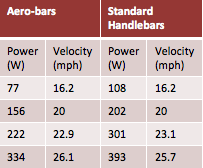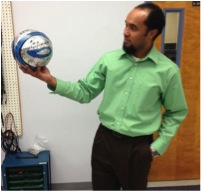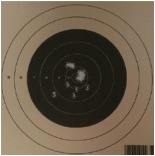
Experimental Methods (EGR 342), Fall 2012. Study of the Effectiveness of Aerobars
During this semester of EGR 342, students were presented with the following scenario:

"You are working as test engineers for Profile Design. Engineers working for Profile Design's product development department have recently developed a new set of aerobars for road bikes. While it is widely believed that aerobars can considerably reduce the aerodynamic drag felt by a road-biker, leading to an improvement in bike speed, the improvement has not been quantified. The marketing department at Profile Design is planning to submit a 2 page article to next month's "Cycling" magazine, proclaiming the revolutionary and cost efficient speed gain that can be achieved by adding these $70 aerobars to a standard road bike. Your project testing team has been tasked with the design, execution, and analysis of a reproducible experiment to quantify the speed gain observed by recreational bikers that typically average 18mph when riding without aerobars..."

The students performed experiments, comparing the cycling speed at constant heart-rate for aerobars and regular road-bike handlebars, leading to an average increase in speed of 1.41mph and a standard deviation of σ=1.03mph. Performing a Student-t test, the students showed that the aerobars resulted in at least a 0.546mph increase in speed at a 95% confidence level. Further, students were presented with test results obtained using a power meter at different velocities, as shown in the Figure. Using the theoretical relation between power and velocity

Where W is the power, KA is a coefficient based on the drag coefficient, cyclist frontal area, and density (KA=CDAρ/2), V is the cyclists velocity, and F is a force due to rolling resistance. Utilizing this equation, students found a reduction in KA from 0.254 for regular handlebars to 0.198 for aerobars, reinforcing the considerable benefit obtained through a more aerodynamic cycling position.
Final Project
For their final project, students in EGR 342 worked in 2 teams and submitted executive summaries of their studies.
 Team 1: Zac Baker, Cody Giles, William Murray, Rainer Pires, Zach Wadley, and Alex Wainscott — investigated the effect of pressure on the performance of soccer balls. Executive Summary of the Project (.pdf)
Team 1: Zac Baker, Cody Giles, William Murray, Rainer Pires, Zach Wadley, and Alex Wainscott — investigated the effect of pressure on the performance of soccer balls. Executive Summary of the Project (.pdf)
 Team 2: Dylan Baker, Alex Charles, Todd Jones, Taylor Mayo, Grace Morriss — undertook a project entitled: "Take your Best Shot" to determine the shooting position with best accuracy and precision.Executive Summary of the Project (.pdf)
Team 2: Dylan Baker, Alex Charles, Todd Jones, Taylor Mayo, Grace Morriss — undertook a project entitled: "Take your Best Shot" to determine the shooting position with best accuracy and precision.Executive Summary of the Project (.pdf)